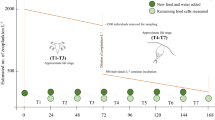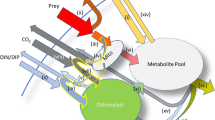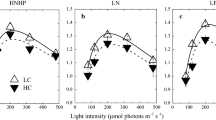Abstract
Rising levels of CO2 in the atmosphere have led to increased CO2 concentrations in the oceans. This enhanced carbon availability to the marine primary producers has the potential to change their nutrient stoichiometry, and higher carbon-to-nutrient ratios are expected. As a result, the quality of the primary producers as food for herbivores may change. Here, we present experimental work showing the effect of feeding Rhodomonas salina grown under different pCO2 (200, 400 and 800 μatm) on the copepod Acartia tonsa. The rate of development of copepodites decreased with increasing CO2 availability to the algae. The surplus carbon in the algae was excreted by the copepods, with younger stages (copepodites) excreting most of their surplus carbon through respiration and adult copepods excreting surplus carbon mostly as DOC. We consider the possible consequences of different excretory pathways for the ecosystem. A continued increase in the CO2 availability for primary production, together with changes in the nutrient loading of coastal ecosystems, may cause changes in the trophic links between primary producers and herbivores.








Similar content being viewed by others
References
Allgaier M, Riebesell U, Vogt M, Thyrhaug R, Grossart HP (2008) Coupling of heterotrophic bacteria to phytoplankton bloom development at different pCO2 levels: a mesocosm study. Biogeosci Discuss 5:317–359
Anderson TR, Hessen DO, Elser JJ, Urabe J (2005) Metabolic stoichiometry and the fate of excess carbon and nutrients in consumers. Am Nat 165(1):1–15
Beardall J, Stoijkovic S, Larsen S (2009) Living in a high CO2 world: impacts of global climate change on marine phytoplankton. Plant Ecol Divers 2(2):191–205
Boersma M (2000) The nutritional quality of P-limited algae for Daphnia. Limnol Oceanogr 45(5):1157–1161
Boersma M, Aberle N, Hantzsche FM, Schoo KL, Wiltshire KH, Malzahn AM (2008) Nutritional limitation travels up the food chain. Int Rev Hydrobiol 93(4–5):479–488
Boersma M, Becker C, Malzahn AM, Vernooij S (2009) Food chain effects of nutrient limitation in primary producers. Mar Freshw Res 60(10):983–989
Burkhardt S, Zondervan I, Riebesell U (1999) Effect of CO2 concentration on C:N:P ratio in marine phytoplankton: a species comparison. Limnol Oceanogr 44(3):683–690
Darchambeau F, Færøvig PJ, Hessen DO (2003) How Daphnia copes with excess carbon in its food. Oecologia 136(3):336–346
DeMott WR, Tessier AJ (2002) Stoichiometric constraints vs. algal defenses: testing mechanisms of zooplankton food limitation. Ecology 83(12):3426–3433
Gervais F, Riebesell U (2001) Effect of phosphorus limitation on elemental composition and stable carbon isotope fractionation in a marine diatom growing under different CO2 concentrations. Limnol Oceanogr 46(3):497–504
Giordano M, Beardall J, Raven JA (2005) CO2 concentrating mechanisms in algae: mechanisms, environmental modulation, and evolution. Ann Rev Plant Biol 56:99–131
Gnaiger E (1983) Calculation of energetic and biochemical equivalents of respiratory oxygen consumption. In: Gnaiger E, Forstner H (eds) Polarographic oxygen sensors. Springer, Berlin, pp 337–345
Grasshoff K, Kremling K, Ehrhardt M (1999) Methods of seawater analysis. Wiley-VCH, Germany
Guillard RR, Ryther J (1962) Studies of marine planktonic diatoms. Can J Microbiol 8:229–239
Hantzsche FM, Boersma M (2010) Dietary-induced responses in the phagotrophic flagellate Oxyrrhis marina. Mar Biol 157:1641–1651
He X, Wang W-X (2008) Stoichiometric regulation of carbon and phosphorus in P-deficient Daphnia magna. Limnol Oceanogr 53(1):244–254
Hein M, Sand-Jensen K (1997) CO2 increases oceanic primary production. Nature 388:526
Hessen DO, Anderson TR (2008) Excess carbon in aquatic organisms and ecosystems: physiological, ecological, and evolutionary implications. Limnol Oceanogr 53(4):1685–1696
Ikeda T, Torres JJ, Hernández-León S, Geiger SP (2000) Metabolism. In: Harris R (ed) ICES zooplankton methodology manual. Academic Press, San Diego, pp 455–532
Jensen TC, Hessen DO (2007) Does excess dietary carbon affect respiration of Daphnia? Oecologia 152:191–200
Jeyasingh PD, Weider LJ (2007) Fundamental links between genes and elements: evolutionary implications of ecological stoichiometry. Mol Ecol 16:4649–4661
Kuffner IB, Andersson AJ, Jokiel PL, Rodgers KS, Mackenzie FT (2007) Decreased abundance of crustose coralline algae due to ocean acidification. Nat Geosci 1:114–117
Kurihara H, Ishimatsu A (2008) Effects of high CO2 seawater on the copepod (Acartia tsuensis) through all life stages and subsequent generations. Mar Pollut Bull 56:1086–1090
Kurihara H, Shimode S, Shirayama Y (2004) Effects of raised CO2 concentrations on the egg production rate and early development of two marine copepods (Acartia steuri and Acartia erythraea). Mar Pollut Bull 49:721–727
Landry MR (1983) The development of marine calanoid copepods with comment on the Isochronal Rule. Limnol Oceanogr 28(4):614–624
Laspoumaderes C, Modenutti B, Balseiro E (2010) Herbivory versus omnivory: linking homeostasis and elemental imbalance in copepod development. J Plankton Res 32(11):1573–1582
Malzahn AM, Boersma M (2012) Effects of poor food quality on copepod growth are dose dependent and non-reversible. Oikos 121(9):1408–1416
Malzahn AM, Aberle N, Clemmesen C, Boersma M (2007) Nutrient limitation of primary producers affects planktivorous fish condition. Limnol Oceanogr 52(5):2062–2071
Malzahn AM, Hantzsche FM, Schoo KL, Boersma M, Aberle N (2010) Differential effects of nutrient-limited primary production on primary, secondary or tertiary consumers. Oecologia 162(1):35–48
Mauchline J (1998) The biology of calanoid copepods, vol 33. Advances in marine biology. Academic Press, New York
Mayor DJ, Matthews C, Cook K, Zuur AF, Hay S (2007) CO2-induced acidification affects hatching success in Calanus finmarchicus. Mar Ecol Prog Ser 350:91–97
Møller EF, Nielsen TG (2001) Production of bacterial substrate by marine copepods: effect of phytoplankton biomass and cell size. J Plankton Res 23(5):527–536
Nejstgaard JC, Båmstedt U, Bagøien E, Solberg PT (1995) Algal constraints on copepod grazing. Growth state, toxicity, cell size, and season as regulating factors. ICES J Mar Sci 52(3–4):347–357
Nielsen LT, Jakobsen HH, Hansen PJ (2010) High resilience of two coastal plankton communities to twenty-first century seawater acidification: evidence from microcosm studies. Marine Biol Res 6(6):542–555
Plath K, Boersma M (2001) Mineral limitation of zooplankton: stoichiometric constraints and optimal foraging. Ecology 82:1260–1269
Prosser CL (1961) Oxygen: respiration and metabolism. In: Prosser CL, Brown FA Jr (eds) Comparative animal physiology. W.B. Saunders, Philadelphia, pp 165–211
Raubenheimer D, Simpson SJ (1999) Integrating nutrition: a geometrical approach. Entomol Exp Appl 91(1):67–82
Riebesell U, Revill AT, Holdsworth DG, Volkman JK (2000) The effects of varying CO2 concentration on lipid composition and carbon isotope fractionation in Emiliania huxleyi. Geochim Cosmochim Acta 64(24):4179–4192
Riebesell U, Schulz KG, Bellerby RGJ, Botros M, Fritsche P, Meyerhofer M, Neill C, Nondal G, Oschlies A, Wohlers J, Zöllner E (2007) Enhanced biological carbon consumption in a high CO2 ocean. Nature 450:545–548
Rossoll D, Bermúdez R, Hauss H, Schulz KG, Riebesell U, Sommer U, Winder M (2012) Ocean acidification-induced food quality deterioration constrains trophic transfer. PLoS ONE 7(4):e34737. doi:10.1371/journal.pone.0034737
Rost B, Riebesell U, Burkhardt S, Sultemeyer D (2003) Carbon acquisition of bloom-forming marine phytoplankton. Limnol Oceanogr 48(1):55–67
Saba GK, Steinberg DK, Bronk DA (2009) Effects of diet on release of dissolved organic and inorganic nutrients by the copepod Acartia tonsa. Mar Ecol Prog Ser 386:147–161
Saba GK, Steinberg DK, Bronk DA (2011) The relative importance of sloppy feeding, excretion, and fecal pellet leaching in the release of dissolved carbon and nitrogen by Acartia tonsa copepods. J Exp Mar Biol Ecol 404:47–56
Schoo KL, Aberle N, Malzahn AM, Boersma M (2010) Does the nutrient stoichiometry of primary producers affect the secondary consumer Pleurobrachia pileus? Aquat Ecol 44(1):233–242
Schoo KL, Aberle N, Malzahn AM, Boersma M (2012) Food quality affects secondary consumers even at low quantities: an experimental test with larval European lobster. PLoS ONE 7(3):e33550. doi:10.1371/journal.pone.0033550
Sterner RW, Elser JJ (2002) Ecological stoichiometry: the biology of elements from molecules to the biosphere. Princeton University Press, Princeton, NJ
Sterner RW, Clasen J, Lampert W, Weisse T (1998) Carbon: phosphorus stoichiometry and food chain production. Ecol Lett 1(3):146–150
Swanson AK, Fox CH (2007) Altered kelp (Laminariales) phlorotannins and growth under elevated carbon dioxide and ultraviolet-B treatments can influence associated intertidal food webs. Glob Change Biol 13(8):1696–1709
Tortell PD, Reinfelder JR, Morel FMM (1997) Active uptake of bicarbonate by diatoms. Nature 390(6657):243–244
Tortell PD, DiTullio GR, Sigman DM, Morel FMM (2002) CO2 effects on taxonomic composition and nutrient utilization in an Equatorial Pacific phytoplankton assemblage. Mar Ecol Prog Ser 236:37–43
Trier TM, Mattson WJ (2003) Diet-induced thermogenesis in insects: a developing concept in nutritional ecology. Environ Entomol 32(1):1–8
Urabe J, Waki N (2009) Mitigation of adverse effects of rising CO2 on a planktonic herbivore by mixed algal diets. Glob Change Biol 15:523–531
Urabe J, Togari J, Elser JJ (2003) Stoichiometric impacts of increased carbon dioxide on a planktonic herbivore. Glob Change Biol 9(6):818–825
van de Waal DB, Verschoor AM, Verspagen JMH, van Donk E, Huisman J (2010) Climate-driven changes in the ecological stoichiometry of aquatic ecosystems. Front Ecol Environ 8(3):145–152
Van Donk E, Lürling M, Hessen DO, Lokhorst GM (1997) Altered cell wall morphology in nutrient-deficient phytoplankton and its impact on grazers. Limnol Oceanogr 42(2):357–364
Vargas CA, Cuevas LA, González HE, Daneri G (2007) Bacterial growth response to copepod grazing in aquatic ecosystems. J Mar Biol Assoc UK 87:667–674
Watanabe Y, Yamaguchi A, Ishida H, Harimoto T, Suzuki S, Sekido Y, Ikeda T, Shirayama Y, Takahashi MM, Oshumi T, Ishizaka J (2006) Lethality of increasing CO2 levels on deep-sea copepods in the Western North Pacific. J Oceanogr 62:185–196
Wiltshire KH, Malzahn AM, Kai Wirtz K, Greve W, Janisch S, Mangelsdorf P, Manly BFJ, Boersma M (2008) Resilience of North Sea phytoplankton spring blooms dynamics: an analysis of long term data at Helgoland Roads. Limnol Oceanogr 53(4):1294–1302
Zanotto FP, Gouveia SM, Simpson SJ, Raubenheimer D, Calder PC (1997) Nutritional homeostasis in locusts: is there a mechanism for increased energy expenditure during carbohydrate overfeeding? J Exp Biol 200(18):2437–2448
Acknowledgments
We would like to thank the German Federal Ministry of Education and Research (BMBF) for funding. This study was part of the BIOACID Project and we are grateful for the support and feedback from our colleagues, particularly Stefanie Schnell. Special thanks are due to Bettina Oppermann and Julia Haafke for technical support. We thank Sam Dupont and two Reviewers, whose comments greatly improved the manuscript.
Author information
Authors and Affiliations
Corresponding author
Additional information
Communicated by S. Dupont.
Rights and permissions
About this article
Cite this article
Schoo, K.L., Malzahn, A.M., Krause, E. et al. Increased carbon dioxide availability alters phytoplankton stoichiometry and affects carbon cycling and growth of a marine planktonic herbivore. Mar Biol 160, 2145–2155 (2013). https://doi.org/10.1007/s00227-012-2121-4
Received:
Accepted:
Published:
Issue Date:
DOI: https://doi.org/10.1007/s00227-012-2121-4




